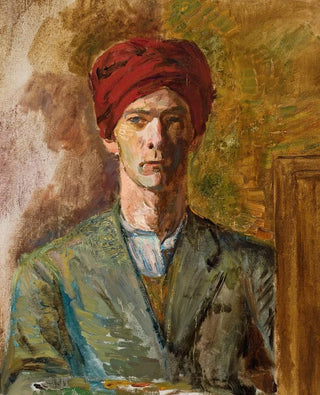Art print | Self-portrait with turban - Zygmunt Waliszewski


View from behind

Frame (optional)
Zygmunt Waliszewski's Self-portrait with Turban is a work that transcends the simple exercise of self-representation. It invites a profound exploration of identity, while fitting into a rich and nuanced artistic context. This painting, which captures the very essence of its creator, is much more than a mere reflection of his appearance; it becomes an entry point into the artist's soul and a reflection on the role of art in understanding oneself. The art print of this piece allows appreciation of the finesse of details and the depth of emotions it conveys, thus paying homage to Waliszewski's unique vision.
Style and uniqueness of the work
The Self-portrait with Turban stands out for its bold style and vibrant color palette. The artist, choosing to depict himself with a turban, evokes diverse cultural influences that testify to his open-mindedness and intellectual curiosity. The brushstrokes, both delicate and assertive, create a texture that seems almost alive, echoing the richness of human experience. The play of light and shadow adds an extra dimension to the piece, reinforcing the sense of depth and introspection. Thus, each element of the composition contributes to the whole, making this work not only aesthetic but also loaded with meanings.
The artist and his influence
Zygmunt Waliszewski, whose artistic journey is marked by an incessant quest for truth and authenticity, positions himself as an emblematic figure of the early 20th century. His work, often imbued with reflections on identity and belonging, finds its roots in a multitude of artistic currents, ranging from symbolism to modernism. Waliszewski managed to capture the spirit of the times while maintaining a personal voice that is uniquely his own. His influence manifests not only in his works but also through the generations of artists he inspired. By redefining the boundaries of the self-portrait, he paved the way for a more introspective exploration of art, where subjectivity becomes fertile ground for creativity.

Matte finish

View from behind

Frame (optional)
Zygmunt Waliszewski's Self-portrait with Turban is a work that transcends the simple exercise of self-representation. It invites a profound exploration of identity, while fitting into a rich and nuanced artistic context. This painting, which captures the very essence of its creator, is much more than a mere reflection of his appearance; it becomes an entry point into the artist's soul and a reflection on the role of art in understanding oneself. The art print of this piece allows appreciation of the finesse of details and the depth of emotions it conveys, thus paying homage to Waliszewski's unique vision.
Style and uniqueness of the work
The Self-portrait with Turban stands out for its bold style and vibrant color palette. The artist, choosing to depict himself with a turban, evokes diverse cultural influences that testify to his open-mindedness and intellectual curiosity. The brushstrokes, both delicate and assertive, create a texture that seems almost alive, echoing the richness of human experience. The play of light and shadow adds an extra dimension to the piece, reinforcing the sense of depth and introspection. Thus, each element of the composition contributes to the whole, making this work not only aesthetic but also loaded with meanings.
The artist and his influence
Zygmunt Waliszewski, whose artistic journey is marked by an incessant quest for truth and authenticity, positions himself as an emblematic figure of the early 20th century. His work, often imbued with reflections on identity and belonging, finds its roots in a multitude of artistic currents, ranging from symbolism to modernism. Waliszewski managed to capture the spirit of the times while maintaining a personal voice that is uniquely his own. His influence manifests not only in his works but also through the generations of artists he inspired. By redefining the boundaries of the self-portrait, he paved the way for a more introspective exploration of art, where subjectivity becomes fertile ground for creativity.






